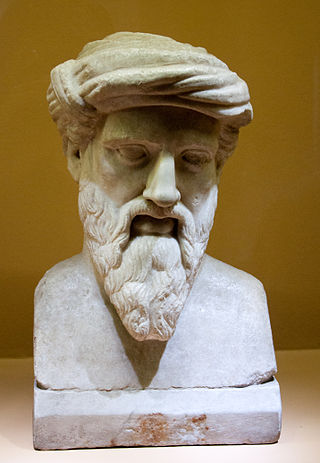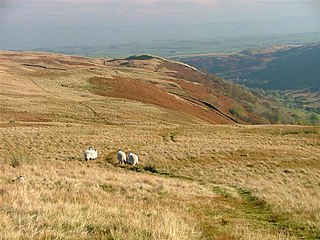
Pythagoras of Samos was an ancient Ionian Greek philosopher and the eponymous founder of Pythagoreanism. His political and religious teachings were well known in Magna Graecia and influenced the philosophies of Plato, Aristotle, and, through them, the West in general. Knowledge of his life is clouded by legend, but he appears to have been the son of Mnesarchus, a gem-engraver on the island of Samos. Modern scholars disagree regarding Pythagoras's education and influences, but they do agree that, around 530 BC, he travelled to Croton in southern Italy, where he founded a school in which initiates were sworn to secrecy and lived a communal, ascetic lifestyle. This lifestyle entailed a number of dietary prohibitions, traditionally said to have included vegetarianism, although modern scholars doubt that he ever advocated complete vegetarianism.

A street is a public thoroughfare in a built environment. It is a public parcel of land adjoining buildings in an urban context, on which people may freely assemble, interact, and move about. A street can be as simple as a level patch of dirt, but is more often paved with a hard, durable surface such as tarmac, concrete, cobblestone or brick. Portions may also be smoothed with asphalt, embedded with rails, or otherwise prepared to accommodate non-pedestrian traffic.

A spur route is a short road forming a branch from a longer, more important road such as a freeway, Interstate Highway, or motorway. A bypass or beltway should not be considered a true spur route as it typically reconnects with another or the same major road.

The Ming tombs are a collection of mausoleums built by the emperors of the Ming dynasty of China. The first Ming emperor's tomb is located near his capital Nanjing. However, the majority of the Ming tombs are located in a cluster near Beijing and collectively known as the Thirteen Tombs of the Ming dynasty. They are located within the suburban Changping District of Beijing Municipality, 42 kilometers (26 mi) north-northwest of Beijing's city center. The site, on the southern slope of Tianshou Mountain, was chosen based on the principles of feng shui by the third Ming emperor, the Yongle Emperor. After the construction of the Imperial Palace in 1420, the Yongle Emperor selected his burial site and created his own mausoleum. The subsequent emperors placed their tombs in the same valley.

Hieros gamos, hieros (ἱερός) meaning "holy" or "sacred" and gamos (γάμος) meaning marriage, or Hierogamy, is a sacred marriage that plays out between a god and a goddess, especially when enacted in a symbolic ritual where human participants represent the deities.

A sacbe, plural sacbeob, or "white road", is a raised paved road built by the Maya civilization of pre-Columbian Mesoamerica. Most connect temples, plazas, and groups of structures within ceremonial centers or cities, but some longer roads between cities are also known. The term "sacbe" is Yucatec Maya for "white road"; white perhaps because there is evidence that they were originally coated with limestone stucco or plaster, which was over a stone and rubble fill.

Velia was the Roman name of an ancient city of Magna Graecia on the coast of the Tyrrhenian Sea. It was founded by Greeks from Phocaea as Hyele around 538–535 BC. The name later changed to Ele and then Elea before it became known by its current Latin and Italian name during the Roman era. Its ruins are located in the Cilento region near the modern village Velia, which was named after the ancient city. The village is a frazione of the comune Ascea in the Province of Salerno, Campania, Italy.

Historic roads are paths or routes that have historical importance due to their use over a period of time. Examples exist from prehistoric times until the early 20th century. They include ancient trackways, long-lasting roads, important trade routes, and migration trails. Many historic routes, such as the Silk Road, the Amber Road, and the Royal Road of the Persian Empire, covered great distances and their impact on human settlements remain today.
Samos is a Greek island in the eastern Aegean Sea.

Samos is a Greek island in the eastern Aegean Sea, south of Chios, north of Patmos and the Dodecanese, and off the coast of western Turkey, from which it is separated by the 1.6-kilometre (1.0 mi)-wide Mycale Strait. It is also a separate regional unit of the North Aegean region.

The Heraion of Samos was a large sanctuary to the goddess Hera, on the island of Samos, Greece, 6 km southwest of the ancient city of Samos. It was located in the low, marshy basin of the Imbrasos river, near where it enters the sea. The late Archaic temple in the sanctuary was the first of the gigantic free-standing Ionic temples, but its predecessors at this site reached back to the Geometric Period of the 8th century BC, or earlier. As a testimony to the mercantile and naval power of Samos during Archaic Greece, and its exceptional architecture, the site of temple's ruins, with its sole standing column, was designated a UNESCO World Heritage Site, along with the nearby archeological site Pythagoreion in 1992.
A Heraion or Heraeum is a temple dedicated to the Greek goddess Hera

Thirunelli Temple is an ancient temple dedicated to Lord Maha Vishnu on the side of Brahmagiri hill in Kerala, India, near the border with Karnataka state. The temple is at an altitude of about 900m in north Wayanad in a valley surrounded by mountains and beautiful forests. It is 32 km away from Manathavady.

A rut is a depression or groove worn into a road or path by the travel of wheels or skis. Ruts can be formed by wear, as from studded snow tires common in cold climate areas, or they can form through the deformation of the asphalt concrete, pavement or subbase material. In modern roads the main cause is heavily loaded trucks. These heavy loaded trucks imprint their tire impressions on roads over time, causing ruts. Rut is a common pavement distress and is often used in pavement performance modeling.

Hasan Abdal, is a city in the Attock District of Punjab Province in Pakistan, located 40 km northwest of the country's capital city, Islamabad. Hassan Abdal is the headquarters of Hasan Abdal Tehsil (sub-district).

Corpse roads provided a practical means for transporting corpses, often from remote communities, to cemeteries that had burial rights, such as parish churches and chapels of ease. In Britain, such routes can also be known by a number of other names, e.g.: bier road, burial road, coffin line, coffin road, corpse way, funeral road, lych way, lyke way, or procession way. etc. Such "church-ways" have developed a great deal of associated folklore regarding ghosts, spirits, wraiths, etc.
In Ancient Greek Religion and mythology, Enodia is a distinctly Thessalian Ancient Greek goddess, identified in certain areas or by certain ancient writers with Artemis, Hecate or Persephone. She was paired with Zeus in cult and sometimes shared sanctuaries with him. Enodia was primarily worshipped in Ancient Thessaly and was well known in Hellenistic Macedonia.

A sacred way, spirit way, spirit road, spirit path, etc. is the ornate road leading to a Chinese tomb of a major dignitary. The sacred way is lined on both sides by a succession of statues, pillars, and stelae. The statues along the spirit way depict real and mythical animals, as well as civilian and military officials.
Shendao teaching also known as














